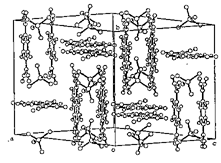
Kazumasa UEDA (Osaka Pref. Univ.), Toyonari SUGIMOTO (Osaka Pref. Univ. and IMS), Toshiharu TADA, Kei-ichiro NISHIMURA, Satoshi ENDO, Naoki TOYOTA, Masakado KOHAMA, Koji YAMAMOTO (Osaka Pref. Univ.), Toshiyuki YAMAGUCHI, Yusaku SUENAGA, Megumu MUNAKATA (Kinki Univ.), Nobuko KANEHISA, Yoshiyuki SHIBAMOTO, Yasushi KAI (Osaka Univ.) and Nobuyoshi HOSOITO (Kyoto Univ.)
[Mol. Cryst. Liq. Cryst. 296, 323 (1997)]
The room-temperature crystal structure of a plate of (PMe4+·TCNQF4-·)·1/2TCNQF4 was analyzed (Figure 1) and very similar to that of the corresponding NMe4+ salt. However, significant difference was recognized between the two crystals in the structures of TCNQF4 and TCNQF4-· molecules, and in the contacts between the dimerized TCNQF4-· molecules and between the TCNQF4 and TCNQF4-· molecules. The change in both molecular structure and contact as above was also observed at a lowering temperature. The magnitude in change was larger in the NMe4+ salt than in the PMe4+ salt. However, such a change in the crystal structure by temperature exerted no special influence on the electrical conducting and magnetic properties.

Figure 1. The room-temperature crystal structure of a plate of (PMe4+TCNQF4-·)·1/2TCNQF4.